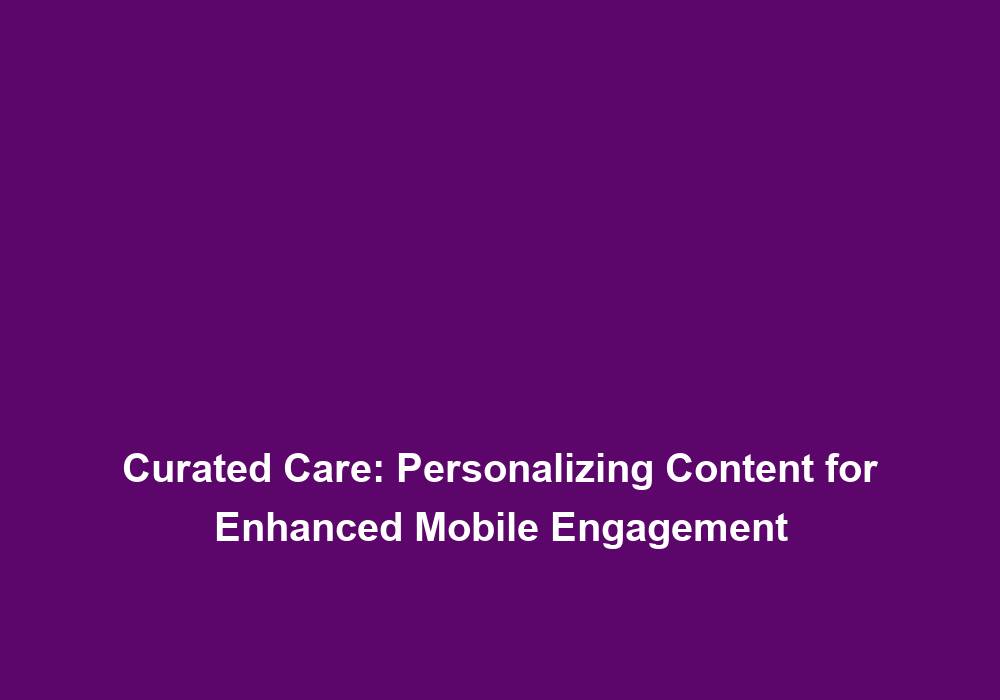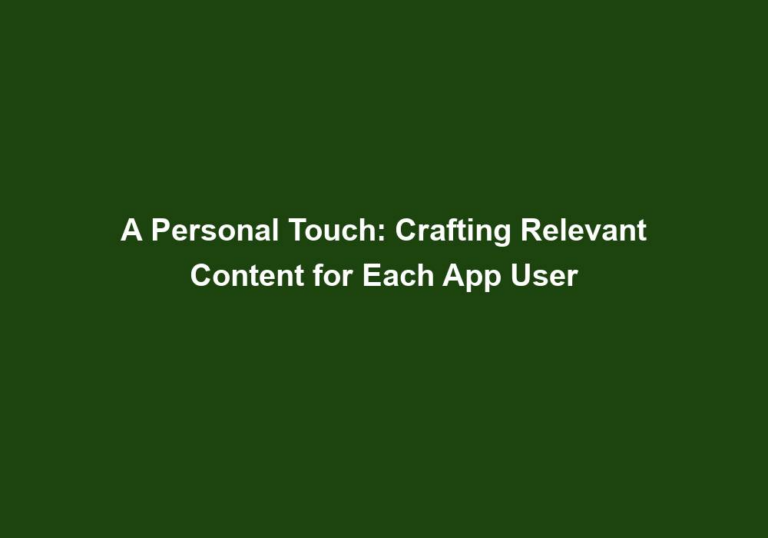Curated Care: Personalizing Content for Enhanced Mobile Engagement
In today’s fast-paced digital world, mobile devices have become an integral part of our lives. With the rise of smartphones and tablets, people are increasingly relying on their mobile devices for various activities, including accessing information and entertainment. As a result, businesses and content creators are constantly striving to enhance mobile engagement and provide a personalized user experience. One effective strategy that has gained popularity is curated care, which involves tailoring content to meet the unique needs and preferences of mobile users.
Understanding Curated Care
Curated care is a concept that revolves around the idea of delivering personalized content to mobile users. It involves understanding the specific needs, interests, and behaviors of the target audience and creating tailored content that resonates with them. By curating content, businesses can ensure that users receive information that is relevant, valuable, and engaging, ultimately increasing their overall mobile engagement.
Curated care goes beyond simply providing generic content. It takes into account the individual characteristics of each user, such as their demographics, interests, and behaviors, to deliver a customized experience. By understanding the unique preferences of the target audience, businesses can create content that captures their attention and keeps them actively involved.
The Importance of Personalization in Mobile Engagement
Personalization plays a crucial role in mobile engagement. With the overwhelming amount of information available online, users are more likely to engage with content that speaks directly to their interests and needs. By personalizing content, businesses can cut through the noise and deliver a seamless and user-centric experience.
Benefits of Personalization in Mobile Engagement
-
Increased User Engagement: When users encounter content that aligns with their preferences, they are more likely to engage with it. Personalization allows businesses to capture the user’s attention and keep them actively involved, leading to longer session durations and increased interaction.
-
Enhanced User Satisfaction: By delivering content that is tailored to the user’s needs, businesses can improve user satisfaction. When users feel that the content is relevant and valuable to them, they are more likely to have a positive perception of the brand and their overall mobile experience.
-
Improved Conversion Rates: Personalization has been proven to positively impact conversion rates. By delivering content that speaks directly to the user’s interests and needs, businesses can increase the likelihood of converting users into loyal customers. When users feel that the content understands and addresses their pain points, they are more inclined to take the desired action, whether it’s making a purchase, signing up for a newsletter, or downloading an app.
Personalization not only benefits the users but also provides advantages for businesses. By delivering tailored content, businesses can establish a stronger connection with their target audience, build brand loyalty, and drive customer retention.
Strategies for Curated Care
Successful implementation of curated care requires a strategic approach. Here are some strategies businesses can employ to personalize content for enhanced mobile engagement:
1. User Segmentation
Segmenting users based on their demographics, interests, and behaviors allows businesses to create targeted content that appeals to specific groups. By understanding the unique characteristics of each segment, businesses can deliver content that meets their specific needs and preferences. For example, an e-commerce website can segment users based on their past purchase history and deliver personalized product recommendations, improving the chances of conversion.
User segmentation helps businesses tailor their content to different user groups, ensuring that each segment receives content that is relevant and valuable to them. This strategy allows businesses to create a more personalized experience for their users, increasing engagement and satisfaction.
2. Behavioral Tracking
Tracking user behavior on mobile devices provides valuable insights into their preferences and interests. By analyzing user interactions, businesses can identify patterns and trends, allowing them to customize content accordingly. For instance, if a user frequently engages with fitness-related content, a health and wellness app can curate personalized workout plans or nutrition tips to enhance their mobile experience.
Behavioral tracking enables businesses to understand the specific interests and preferences of individual users. By leveraging this data, businesses can deliver highly targeted and relevant content that resonates with their audience, increasing engagement and fostering a deeper connection with users.
3. Dynamic Content
Dynamic content refers to content that changes based on the user’s behavior or preferences. By leveraging technologies such as artificial intelligence and machine learning, businesses can deliver real-time personalized content that adapts to the user’s needs. For example, an online news platform can display news articles based on the user’s reading habits and interests, ensuring a highly relevant and engaging experience.
Dynamic content allows businesses to provide users with up-to-date and relevant information that aligns with their preferences. By delivering content that adapts to the user’s behavior, businesses can create a more personalized and engaging mobile experience.
4. Feedback and Surveys
Collecting feedback and conducting surveys can provide valuable insights into what users are looking for in terms of content. By actively seeking user opinions and preferences, businesses can refine their content strategy and deliver personalized experiences that resonate with their target audience. Additionally, feedback mechanisms allow businesses to continuously adapt and improve their content to meet changing user needs.
Feedback and surveys help businesses gather direct input from their users, allowing them to better understand their preferences and expectations. By incorporating user feedback into their content strategy, businesses can ensure that their content remains relevant, valuable, and engaging to their target audience.
Best Practices for Curated Care
While implementing curated care, businesses should keep in mind certain best practices to ensure optimal results:
-
Data Privacy: With the increasing emphasis on personalization, it is essential for businesses to prioritize data privacy. Users should have control over their data and be informed about how their information is being used. Implementing transparent data privacy policies helps establish trust and fosters a positive relationship with users.
-
Consistency Across Channels: To deliver a seamless and personalized experience, it is crucial for businesses to maintain consistency across different channels, including mobile apps, websites, and social media platforms. Users should receive consistent messaging and content regardless of the platform they are using.
-
Regular Monitoring and Optimization: The success of curated care relies on continuous monitoring and optimization. By analyzing user feedback, engagement metrics, and conversion rates, businesses can identify areas for improvement and make necessary adjustments to their content strategy.
-
Experimentation and A/B Testing: To maximize the effectiveness of curated care, businesses should regularly experiment with different content variations and perform A/B testing. This allows them to identify the most successful approaches and refine their content strategy accordingly.
In conclusion, curated care is a powerful strategy for enhancing mobile engagement by providing personalized content that meets the unique needs and preferences of users. By implementing user segmentation, behavioral tracking, dynamic content, and feedback mechanisms, businesses can create compelling and relevant experiences that drive user engagement, satisfaction, and ultimately, conversion. Embracing these best practices and continuously optimizing the content strategy will help businesses stay at the forefront of mobile engagement and deliver exceptional user experiences in the digital era.






